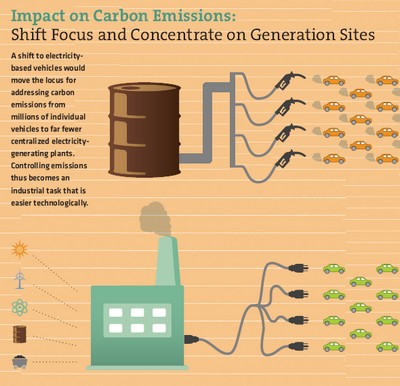
Image from the Andy Grove article in American.com
I wrote a post about Plug-In hybrid vehicles and their potential value to the grid the other day.
Since then I have seen several other articles published from eminent sources which seem to back the thesis that electric vehicles are the way to go.
Andy Grove, former CEO of Intel, in an excellent article called Our Electric Future said:
We live in a world where just about everything—from a hairdryer to the Internet—runs on electricity. A big exception is the transportation sector, critical to the movement of people, production materials, food, and even fuel. Transportation uses more than half of all the petroleum consumed in this country. If we don’t convert a large portion of the transportation sector to electricity, we cannot make real progress toward energy resilience…
Startups like Tesla Motors and Project Better Place have begun to experiment with all-electric cars, and important developments are underway at Nissan and General Motors. But our exposure to the vagaries of oil supply is growing by the month.
We must accelerate conversion to electricity in a major way….
Estimates show that converting these vehicles [SUVs, vans, pickups] to dual-fuel operation, even with electricity providing no more than 50 miles of driving range between daily recharging, could cut petroleum imports by 50 to 60 percent—a stunning opportunity….
A policy that favors sticky energy with multiple sources and that aggressively moves vehicles first toward dual-fuel mode and ultimately to running on just electricity provides the answer.
Then I see the following excellent video of FedEx CEO Fred Smith speaking at the Plug-in Vehicles 2008: What Role for Washington? conference dinner.
In this 36 minute video Fred speaks of, amongst other things, FedEx’s multi-billion $ investments in efficiency, he pooh, pooh’s cap and trade in favour of carbon taxes and at about 26 minutes into the video he promises to issue an RFP for an Electric powered fleet. The FedEx fleet consists of around 80,000 vehicles. An RFP from FedEx for 80,000 electric vehicles would be a fabulous kick start to this nascent industry.
Finally, I see CNet reporting that General Motors is teaming up with utilities to develop a charging infrastructure for electric cars by 2010.
The future of transportation is still pretty much up in the air but one thing is certain and that is that transport based on the internal combustion engine has no future. The best alternatives at the moment seem to be either electric or hydrogen powered vehicles.
Given that hydrogen cars are electric cars with the addition of a fuel cell and hydrogen storage you have to suspect that electric cars will work out cheaper to produce and with the right batteries, just as efficient.


